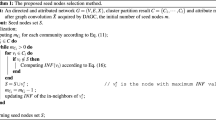Abstract
Influence Maximization, aiming at selecting a small set of seed users in a social network to maximize the spread of influence, has attracted considerable attention recently. Most existing influence maximization algorithms focus on pure networks, while in many real-world social networks, nodes are often associated with a rich set of attributes or features, aka attributed networks. Moreover, most of existing influence maximization methods suffer from the problems of high computational cost and no performance guarantee, as these methods heavily depend on analysis and exploitation of network structure. In this paper, we propose a new algorithm to solve community-based influence maximization problem in attributed networks, which consists of three steps: community detection, candidate community generation and seed node selection. Specifically, we first propose the candidate community generation process, which utilizes information of community structure as well as node attribute to narrow down possible community candidates. We then propose a model to predict influence strength between nodes in attributed network, which takes advantage of topology structure similarity and attribute similarity between nodes in addition to social interaction strength, thus improve the prediction accuracy comparing to the existing methods significantly. Finally, we select seed nodes by proposing the computation method of influence set, through which the marginal influence gain of nodes can be calculated directly, avoiding tens of thousands of Monte Carlo simulations and ultimately making the algorithm more efficient. Experiments on four real social network datasets demonstrate that our proposed algorithm outperforms state-of-the-art influence maximization algorithms in both influence spread and running time.





Similar content being viewed by others
References
Domingos P, Richardson M (2001) Mining the network value of customers. In: Proc SIGKDD, San Francisco, pp 57–66
Richardson M, Domingos P (2002) Mining knowledge-sharing sites for viral marketing. In: Proc SIGKDD, Edmonton, Alberta, pp 61–70
Kempe D, Kleinberg J, Tardos E (2003) Maximizing the spread of influence through a social network. In: Proc SIGKDD, Washington, pp 137–146
Leskovec J, et al. (2007) Cost-effective outbreak detection in networks. In: Proc SIGKDD, San Jose, pp 420-429
Chen W, Wang Y, Yang S (2009) Efficient influence maximization in social networks. In: Proc SIGKDD, Paris, pp 199–208
Cheng S, Shen H, Huang J (2013) Staticgreedy: solving the scalability-accuracy dilemma in influence maximization. In: Proc CIKM, San Francisco, pp 509–518
Goyal A, Lu W, Lakshmanan LV (2011) Celf++: optimizing the greedy algorithm for influence maximization in social networks. In: Proc WWW, Hyderabad, India, pp 47–48
Galhotra S, Arora A, Roy S (2016) Holistic influence maximization: Combining scalability and efficiency with opinion-aware models. In Proc SIGMOD, San Francisco, pp 743–758
Tang Y, Xiao X, Shi Y (2014) Influence maximization: near-optimal time complexity meets practical efficiency. In: Proc SIGMOD, Snowbird, pp 75–86
Tang Y, Shi Y, Xiao X (2015) Influence maximization in near-linear time: a martingale approach. In: Proc SIGMOD, Melbourne, pp 1539-1554
Luo ZL, Cai WD, Li YJ, Peng D (2012) A pagerank-based heuristic algorithm for influence maximization in the social networks. In: Proc RPDEIT, pp 485–490
Cao T, Wu X, Wang S, Hu X (2010) Oasnet: an optimal allocation approach to influence maximization in modular social networks. In: Proc SAC, Sierre, Switzerland, pp 1088–1094
Chen YC, Zhu WY, Lee WC, Lee SY (2014) Cim:, communitybased influence maximization in social networks. IEEE Trans Intell Syst Technol 5(2):25:1–25:31. https://doi.org/10.1145/2532549
Li H, Bhowmick SS, Sun A, Cu J (2015) Conformity-aware influence maximization in online social networks. VLDB J 24:117–141. https://doi.org/10.1007/s00778-014-0366-x
Wang Y, Cong G, Song G, Xie K (2010) Community-based greedy algorithm for mining top-k influential nodes in mobile social networks. In: Proc SIGKDD, Washington, pp 1039–1048
Chen W, Wang C, Wang Y (2010) Scalable influence maximization for prevalent viral marketing in large-scale social networks. In: Proc SIGKDD, pp 1029–1038
Blondel VD, Guillaume J-L, Lambiotte R, Lefebvre E (2008) Fast unfolding of communities in large networks. J Stat Mech Theory Exp 2008(10):P10008
Meng Z, Shen H (2018) Dissimilarity-constrained node attribute coverage diversification for novelty-enhanced top-k search in large attributed networks. Knowl-Based Syst 150:85–94
Tang J, Wu S, Sun J (2013) Confluence: conformity influence in large social networks. In: Proceddings of SIGKDD, pp 347– 355
Chen W, Lakshmanan LVS, Castillo C (2013) Information and influence propagation in social networks California: Morgan & Claypool publishers
McPherson M, Smith-Lovin L, Cook JM (2001) Birds of a feather: homophily in social networks. Ann Rev Sociol 274:15–444
Shang J, Zhou S, Li X, Liu L, Wu H (2017) CoFIM: A community-based framework for influence maximization on large-scale networks. Knowl-Based Syst 117:88–100
Shang J, Liu L, Li X, et al. (2016) Targetd revision: a learning-basd approach for incremental community detection in dynamic networks. Physica A:, Statistical Mechanics and its Applications 443:70–85
Bi J, Zhang C (2018) An empirical comparison on state-of-the-art multi-class imbalance learning algorithms and a new diversified ensemble learning scheme. Knowl-Based Syst 158:81–93
Zhang X, Zhu J, Wang Q, Zhao H (2013) Identifying influential nodes in complex networks with community structure. Knowl-Based Syst 42:74–84
Acknowledgments
This work is supported by National Key R & D Program of China Project #2017YFB0203201 and Australian Research Council Discovery Project DP150104871.
Author information
Authors and Affiliations
Corresponding author
Additional information
Publisher’s note
Springer Nature remains neutral with regard to jurisdictional claims in published maps and institutional affiliations.
Rights and permissions
About this article
Cite this article
Huang, H., Shen, H. & Meng, Z. Community-based influence maximization in attributed networks. Appl Intell 50, 354–364 (2020). https://doi.org/10.1007/s10489-019-01529-x
Published:
Issue Date:
DOI: https://doi.org/10.1007/s10489-019-01529-x




